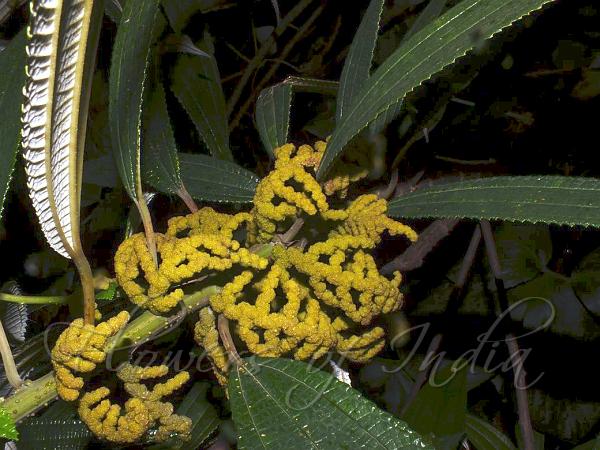|
| Dogal Tree |
|

|

| File size | 299263 |
| Original date | 6/21/17 1:38 PM |
| Resolution | 4608 x 3456 |
| Flash | Flash fired |
| Focal length | 7.3mm |
| Exposure time | 1/4000s |
| Aperture | 11.0 |
| Focus Distance | 0.0m |
| Metering Mode | Spot |
| Camera make | FUJIFILM |
| Camera model | FinePix HS35EXR |
| Sensor type | OneChipColorArea |
|
|
|
|
Photo: |
Botanical name: Sarcochlamys pulcherrima Family: Urticaceae (Nettle family)
Synonyms: Urtica pulcherrima, Sphaerotylos medogensis
Synonyms: Urtica pulcherrima, Sphaerotylos medogensis
Dogal Tree is a small evergreen tree or shrub, 2-6 m
tall, with branchlets and leaf-stalks densely velvet-hairy. Stipules
are triangular-ovate, 8-10 mm; leaf-stalk 2-6 cm; leaf blade
lanceshaped to narrowly lanceshaped, 12-22 x 3-6 cm, thinly leathery,
basal-lateral veins reaching to tip, secondary veins 3 or 4 pairs,
upper surface dark green, nearly hairless, lower surface grayish woolly
and appressed velvet-hairy on veins, base broadly wedge-shaped or
subrounded, margin minutely toothed, tip tapering or long tapering.
Flowers are borne in cyme-like panicles 7-9 cm, glomerules 2-4 mm in
diameter. Male flowers are nearly stalkless, about 0.8 mm in diam.
Female flowers are 0.3-0.5 mm. Achene are about 0.5 mm. Young shoots,
leaves, and fruits are eaten as vegetable favored with pork, especially
by Mishing people of Assam.
Dogal Tree is found in Tropical rain forests, open and damp secondary
forests on floodplains, at altitudes of 800-1400 m, in NW Yunnan,
Bhutan, NE India, Indonesia, Myanmar, Thailand. Flowering: April-June.
Medicinal uses: Leaves are used for feeding
cattle, buffaloes and pig, tender leaves are recommended in diarrhoea
and dysentery.
Leaves are used for feeding
cattle, buffaloes and pig, tender leaves are recommended in diarrhoea
and dysentery.
Medicinal uses:
 Leaves are used for feeding
cattle, buffaloes and pig, tender leaves are recommended in diarrhoea
and dysentery.
Leaves are used for feeding
cattle, buffaloes and pig, tender leaves are recommended in diarrhoea
and dysentery. | Identification credit: Nidhan Singh | Photographed in Tippi, Arunachal Pradesh. |
• Is this flower misidentified? If yes,